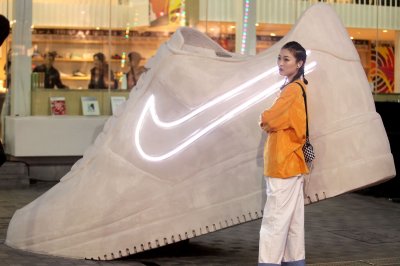
June 27 (UPI) — Nike is forecasting a rebound from slow sales and profits in the last quarter and despite $1 billion in added tariff costs on foreign goods of its sneakers and athletic gear.
The company, headquartered in Beaverton, Ore., said Thursday the tariff costs can be mitigated with products made elsewhere, and additional costs will be passed onto customers.
In late 2024, sales dropped 12% to $11.1 billion, the lowest since the third quarter of 2022, according to a report issued Thursday. Net income for the quarter plunged 86% to $200 million.
For fiscal 2025, Nike reported revenues of $46.3 billion — a 10% decline from fiscal 2024. Net income was 3.2 billion, down 44%.
The company posted an earnings per share of 14 cents for its fourth quarter, which is much lower than 99 cents the company posted in the same quarter a year earlier. Dividends were $2.3 billion, up 6% from the previous year.
CEO Elliott Hill said in an earnings call that the company’s worst days are behind it, and profits would begin to moderate in the quarters ahead.
“The results we’re reporting today in Q4 and in FY25 are not up to the Nike standard, but as we said 90 days ago, the work we’re doing to reposition the business through our ‘Win Now’ actions is having an impact,” said Hill on an earnings call, referencing the name of the company’s turnaround plan. “From here, we expect our business results to improve. It’s time to turn the page.”
Hill was brought in to lead the company last year to change its economic situation.
The company’s shares initially fell when it posted results after the closing bell Thursday. At the end of trading, the stock price was $61.56. On Friday, it went above $74, which is a 17% increase.
HSBC also raised its price target to $80. The all-time high Nike closing price was $168.16 on Nov. 05, 2021.
“Don’t hope for a V-shape, more like a Swoosh, but it does seem like a recovery is finally on its way after years of pain,” HSBC analyst Erwan Rambourg wrote in a note released Friday. “Sales momentum gets better from here; gross margin pressures should also start to ease later this year despite tariffs.”
“Long in the making but we think the inflection is finally here,” Rambourg wrote. “We think there is more than tangible evidence that Nike has a path to see its sales rebound in the not-too-distant future, and its margins to be repaired, and this despite an unfavorable tariff headwind.”
Nike confirmed it would take a $1 billion from tariffs, including in two countries where its goods are made: China and Vietnam.
China now manufactures 16% of Nike footwear that goes to the U.S. and plans are to reduce that to single digit.
In April, President Donald Trump placed a 46% tariff on products manufactured in Vietnam and 146% on goods made in China. He later reduced both rates with 10% in Vietnam and 30% in China.
Most U.S. trading partners have had the 10% baseline tariff after Trump paused higher ones until July 9 on the worst offenders, including China and Vietnam. Trump has said the pause could be extended.
Last month, the U.S. and China agreed trade a trade agreement that includes the Asian nation sending more rare earth metals to the U.S. in return for lifting export restrictions.
CFO Matt Friend said during the earnings call the tariffs “represent a new and meaningful cost headwind,” but they will “fully mitigate” the costs by reducing its supply chain reliance on China to single digits.
Hill described the turnaround plans, including boosting sales to female shoppers. During the last quarter, the company launched products in more than 200 female-led shops, including Aritzia. It also added a collection with WNBA star A’ja Wilson.
Nike has begun plans to sell on Amazon.
“Nike, Jordan and Converse teams will now come to work every day with a mission to create the most innovative and coveted product, footwear, apparel, and accessories for the specific athletes they serve,” Hill said. “These sport-obsessed teams will create greater dimension and distinction for our three brands, will make us more competitive, and will accelerate our growth.”